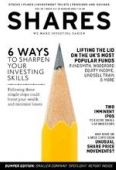Archived article
Please note that tax, investment, pension and ISA rules can change and the information and any views contained in this article may now be inaccurate.
When will developed economies be removed from life support?

Overshadowed by the devastation wrought by Hurricane Harvey in Texas and North Korea firing a missile over Japan, the Jackson Hole meeting of central bankers in Wyoming in late August is interesting for what was not said as much as what was said.
The action of North Korea in launching an intercontinental ballistic missile over Japanese territory has stoked fears of conflict between the US and the communist state. It has helped drive gold prices through $1,300 as investors head for safe havens.
But in the long-term the decisions taken by the attendees of the Jackson Hole meeting might have more bearing on the performance of stocks. That’s because the summit has become increasingly important for investors in recent years.
In 2014 the current head of the European Central Bank, Mario Draghi, gave hints of the financial stimulus he would later launch to rescue eurozone economies which had been buffeted by several sovereign debt crises.
In 2010 the-then chair of the Federal Reserve, Ben Bernanke, made his own commitment to so-called quantitative easing (QE) in the wake of the global financial crisis.
Lack of clarity
This year it was hoped that current Fed chair Janet Yellen and Draghi would use their respective speeches at Jackson Hole to discuss how they would take the world’s developed economies off life support by scaling back QE and returning interest rates to more normal levels. Both disappointed the market.
The US is further along in the process. It started raising interest rates in December 2016 and halted its QE programme in October 2014 whereas the ECB has extended its own QE until the end of 2017.
When rates move higher (and stimulus is removed) there will be less money in the system and interest charges on borrowings will increase. This can lead to spending being scaled back.
If people are buying fewer products and services or if investment within businesses declines then estimated cash flows for most listed companies will likely fall. This situation will typically result in lower share prices.
An increase in rates should also boost the return from assets such as cash and bonds which are typically seen as being lower risk than shares. In these circumstances investors may choose to take their money out of the stock market.
What next?
The markets will be watching Draghi and Yellen closely when they next update the market on their plans on 7 September and 20 September respectively.
Important information:
These articles are provided by Shares magazine which is published by AJ Bell Media, a part of AJ Bell. Shares is not written by AJ Bell.
Shares is provided for your general information and use and is not a personal recommendation to invest. It is not intended to be relied upon by you in making or not making any investment decisions. The investments referred to in these articles will not be suitable for all investors. If in doubt please seek appropriate independent financial advice.
Investors acting on the information in these articles do so at their own risk and AJ Bell Media and its staff do not accept liability for losses suffered by investors as a result of their investment decisions.

 magazine
magazine










